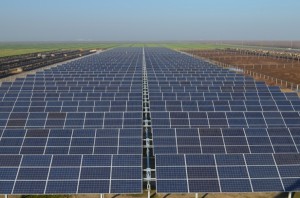Single-axis trackers are fast to install, easy to maintain and generate the most solar energy at the lowest lifetime cost.
By Tim Cain
The goal of solar power is to lower costs, generate savings and provide a hedge against rising energy rates. Solar developers, financiers, utilities and businesses are all looking for a viable economic model to maximize a solar project’s return on investment (ROI). Driving down the cost of solar hardware and increasing productivity are the sure ways to maximize the ROI of a solar power system.
 “I’ve seen a lot of changes in the industry,” says project superintendent Kevin Rosales, a 12-year veteran with SPG Solar, a provider of solar technologies and services for commercial and utility-scale solar projects. “The fierce competition, low cost of solar panels and dwindling energy rebates have made us look for ways to streamline our processes while maintaining high quality. Single-axis trackers were the natural answer.”
“I’ve seen a lot of changes in the industry,” says project superintendent Kevin Rosales, a 12-year veteran with SPG Solar, a provider of solar technologies and services for commercial and utility-scale solar projects. “The fierce competition, low cost of solar panels and dwindling energy rebates have made us look for ways to streamline our processes while maintaining high quality. Single-axis trackers were the natural answer.”
INCREASE PRODUCTION
In an effort to increase solar output, single-axis trackers have become the “go-to” racking solution since they increase production by up to 30 percent. Traditionally open fields used a fixed-tilt system, with the introduction of single-axis trackers and the lower levelized cost of energy (LCOE), trackers have become the mainstream ground-mount solution.
The decision to choose between a fixed-tilt and a single-axis tracker depends on geography, land, soil type, foundations and module stringing. Historically, there were reservations about a single-axis tracker and the increased maintenance and ground cover ratio (GCR). However, the technology has improved and most single-axis trackers require less than 16 man-hours of maintenance annually per megawatt and use a backtracking algorithm. So even with GCRs higher than 40 percent, the economics for a single-axis tracker still make sense in the Southwest compared to a fixed-tilt.
“The best tracker is one that’s been designed to shorten the overall installation timeline,” Rosales says. “Take the latest SunSeeker tracker, for instance; we ensured that it has a smaller footprint, one-third of the piers per megawatt and requires fewer materials and less labor. This all adds up to one thing: faster installation, which translates into lower costs that we can pass on to our customers in the form of lower project pricing.”
 INSTALLATION-FRIENDLY
INSTALLATION-FRIENDLY
Single-axis trackers, like any other solar power system, are only as successful as their installation. Tracker installation can be divided into four important areas: foundation installation, racking installation, commissioning and operations and maintenance (O&M).
Foundation Installation
Vibro-piling wide flange beams is the preferred method of tracker installation for those who want to reduce costs, mitigate land impact and shorten construction timelines. Laying out the foundation with survey points versus string lines or other methods will increase efficiency and accuracy, thereby reducing labor costs. It is absolutely critical to have the proper machinery and skilled installation crew for this — a typical crew consists of one operator on the vibro-pile machine, one on the skid steer and one laborer verifying accurate placement and elevation of the pile. Maintaining pier tolerances in x, y, z directions eases installation of the tracker’s racking components and improves the overall quality of the installation.
Racking Installation
Staging materials during the installation of the piers increases the efficiency of the installation and cuts down on the time required to install the racking. This process can be separated into four segments — motor and controller installation, driveline installation, array wing installation and module installation. The most efficient way to tackle these segments is to deploy crews on each of these tasks. And, as with any racking product, quality control of the installation crews is critical to the success of the installation. Because welding has been eliminated with most single-axis trackers, the need for special on-site inspections is reduced, thereby decreasing the build cycletime.
Commissioning
It’s important to understand the system’s configurations and input variables prior to starting commissioning. This ensures that proper safety protocols are in place and removes the risk of improper configuration. Documentation of the system configurations and settings is important for O&M crews to troubleshoot the system in the future if required. Most systems have minor adjustment points to accommodate any aesthetic concerns, which may be small but are critical to the overall look of the system.
O&M
A well-established training manual or program — including installation and commissioning records — should be in place for any installation. Service technicians should be certified, trained and knowledgeable of the systems they are maintaining. While O&M requirements for systems vary, proper maintenance of the system is key to its uptime. If trackers are properly maintained, an uptime of up to 99 percent can be expected for most systems.
As the cost of solar continues to dramatically decline, with the price of solar panels falling 41 percent from 2011 to 2012 and the installed price of solar dropping 27 percent, prices are expected to continue to drop, but they will eventually bottom out. Improving production, therefore, becomes even more imperative. The simple installation of a single-axis tracking system increases a system’s output and maximizes a project’s ROI.
Tim Cain is vice president of product management at SPG Solar. Visit spgsolar.com for more information.
A step-by-step illustration of how to install a tracking system can be seen in the latest issue of Solar Builder.
— Solar Builder magazine
[source: http://www.solarbuildermag.com/featured/spg-solar-tracker-system/]

Leave a Reply
You must be logged in to post a comment.